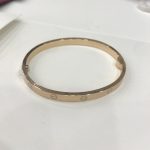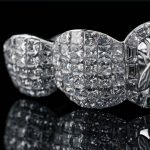Does Anylovey Replica Jewelry Really Match 1:1 with the Originals?
In the world of high-end jewelry, replica pieces have become increasingly popular for those seeking the luxury look without the hefty price tag. But a common question is:
“Can replica jewelry really be 1:1 with the original?”
Many sellers claim their pieces are “perfect 1:1 copies,” but is that truly possible? In this blog, we’ll dive into what makes a replica 1:1 quality, what to look for, and whether you can actually get a piece that is indistinguishable from the real thing.
What Does real “1:1” Mean in Replica Jewelry?
When sellers advertise their jewelry as 1:1, they mean the replica is identical in appearance, weight, and craftsmanship to the authentic piece. This includes:
- Exact dimensions – Matching the size, thickness, and proportions of the original.
- Precise stone placement – Using the same number, size, and positioning of gemstones.
- Identical metal finish – With the same polish, texture, and color.
- Authentic markings – Including engraved logos, serial numbers, and hallmarks.
- Weight and feel – Replicating the original’s weight with the same materials (real gold, genuine gemstones).
However, not all replicas are made equally. Some may look similar at first glance but lack the fine details, while true 1:1 replicas are virtually indistinguishable, even to trained eyes.
What Makes a Replica Truly 1:1?
High-Quality Materials
The best replicas use real gold (14K/18K) and genuine gemstones (moissanite, lab diamonds, or high-grade cubic zirconia). This gives them the same shine, weight, and durability as the original.
Example: A 1:1 Van Cleef Alhambra necklace should have solid gold links and precisely cut motifs, not plated metal.
Flawless Craftsmanship
A true 1:1 replica requires expert craftsmanship. This includes:
- Invisible stone settings (like Van Cleef) that look seamless.
- Precise logo engraving with sharp and clean lines.
- Polished edges and smooth finishes, matching the original’s refinement.
Accurate Details and Branding
A genuine 1:1 replica includes correct markings—such as serial numbers, hallmarks, and brand engravings—placed in the exact location as the original.
Example: Cartier replicas should have engraved screw motifs with the same depth and spacing, making it almost impossible to tell apart from the authentic piece.
Can You Spot the Difference?
With top-tier 1:1 replicas, even jewelry experts may struggle to spot the difference without professional tools.
- To the naked eye: A well-made replica will look and feel identical to the original.
- Under magnification: Some subtle differences may appear, such as slightly different laser engraving depths or variations in internal gemstone flaws.
- Hallmarks and weight: With real gold replicas, the weight is the same, making it even harder to tell apart.
Tip: A 1:1 replica with real gold and genuine stones is nearly impossible to distinguish from the authentic piece without expert evaluation.
The Difference Between 1:1 and Lower-Grade Replicas
Not all replicas are equal. Here’s how 1:1 replicas compare to lower-quality copies:
1:1 Replica:
- Real gold, genuine stones
- Sharp, precise, and clean engraving
- Perfectly aligned, flawless stone setting
- Same weight as the original
- Correct fonts, spacing, and depth of logos
Lower-Grade Replica:
- Plated metal, synthetic stones
- Blurry or shallow engraving
- Loose or uneven stones
- Lighter, cheaper feel
- Slight font or size variations in logos
A true 1:1 replica uses authentic materials and expert craftsmanship, making it nearly identical to the original, while lower-grade replicas are easy to spot due to cheap materials and sloppy details.
How to Identify a High-Quality 1:1 Replica
When buying replica jewelry, here’s what to look for:
- Material authenticity: Ask if the piece uses real gold and genuine stones.
- Close-up photos: Check for precise stone setting, sharp logo engraving, and clean edges.
- Weight and feel: High-quality replicas will have the same weight as the original.
- Seller transparency: Reliable sellers will provide detailed specs, including gold karat, weight, and stone details.
How Is Anylovey Different From Other Replica Jewelry Sellers?
While many sellers claim to offer 1:1 replica jewelry, Anylovey stands out in several key areas:
Own Factory and Skilled Craftsmanship
Unlike many resellers who simply source their products, Anylovey has its own factory with over 10 years of experience. The skilled jewelers have more than 20 years of expertise in fine jewelry craftsmanship, including advanced settings like the invisible setting used by Van Cleef. This ensures the jewelry meets higher standards of quality and precision.
Real Gold and Genuine Stones
Anylovey uses real 14K or 18K gold and authentic gemstones (moissanite, lab diamonds) for a more realistic appearance and feel. This guarantees that the jewelry will not tarnish over time and retains its shine, unlike cheap gold-plated pieces.
Free CAD Design and Customization
Anylovey offers free CAD design services, allowing customers to customize their jewelry at no extra cost. Most sellers only offer pre-made pieces with no flexibility. With Anylovey, customers can modify the size, stone shape, and other details to create a truly unique piece.
Fast and Safe Delivery
While many sellers take weeks to deliver, Anylovey provides fast production (7-10 days) and express shipping (3-5 days) through reliable carriers like DHL and FedEx. This ensures quick and secure delivery without long waiting times.
High Repeat Customer Rate
Anylovey has built a reputation for quality and reliability, with 80-90% of its customers returning for repeat purchases. This speaks to the consistent quality and satisfaction of its clients, unlike many fly-by-night sellers.
Flawless Details and Realistic Finishing
Anylovey focuses on perfecting every detail, from sharp and precise logo engraving to flawless stone settings. The pieces are polished and finished with the same level of craftsmanship as the originals, making them nearly impossible to tell apart.
Transparent Pricing and Secure Payment
Anylovey offers clear pricing with no hidden fees and accepts secure payment methods like Wise, Remitly, and bank transfers. Customers are kept informed throughout the process, ensuring peace of mind.
Conclusion: Can Replica Jewelry Really Be 1:1?
In reality, 1:1 is just a marketing term. People should understand that every piece of jewelry is unique, even the original brands can’t make every piece exactly the same. In my opinion, 1:1 means that no one can tell the difference when you wear it in your daily life, rather than it being 100% identical.
The money you spend on a replica compared to the original is completely different. It’s also important to realize that it’s nearly impossible for one factory to produce flawless replicas of all designer brands. The R&D costs for each piece would be astronomical—who would cover those expenses?
So, while replica jewelry can get incredibly close, customers should have a reasonable expectation. A high-quality replica offers the same look and feel in daily wear, but it’s unrealistic to expect absolute perfection.
Why Do Some Sellers Offer Replica Jewelry Cheaper Than Anylovey?
1. Lower-Quality Materials
One of the main reasons some sellers can offer lower prices is because they use cheaper materials. While Anylovey uses 18K gold and genuine diamonds or moissanite, some sellers cut costs by:
- Using 14K or even 10K gold instead of 18K. This reduces their gold cost significantly, but to the naked eye, most customers won’t notice the difference.
- Lower-grade diamonds or synthetic stones. Some sellers use low-quality or even fake diamonds with poor clarity and color, making their jewelry cheaper. The problem is, unless you inspect it with professional tools, it’s hard to tell the difference just by appearance.
Key point: You might think you’re getting a “great deal,” but in reality, the materials used are inferior, even if they look similar at first glance.
2. Reduced Gold Weight and Size
Some sellers lower their production costs by reducing the gold weight, thickness, or overall size of the jewelry. For example:
- The band thickness on a bracelet might be slightly thinner, making it lighter and cheaper.
- The diamond count or carat weight may be reduced without making it obvious.
- The entire piece might be made slightly smaller to save on materials.
The catch: These small changes can be difficult to notice without direct comparison, but they significantly lower the production cost.
3. Different Quality Standards
When it comes to “good quality,” everyone has a different standard.
- A seller might claim their jewelry is “high quality,” but in reality, it may only be good based on their own definition.
- What looks flawless to one person may appear cheap or poorly made to another.
- Some factories prioritize speed and cost-efficiency over quality, producing cheaper pieces with visible flaws that some customers may overlook.
Key point: When customers say, “Oh, my supplier offers great quality at a lower price,” it often comes down to subjective standards. What they consider “good” might not meet Anylovey’s higher standards.
4. Cutting Corners on Craftsmanship
Some sellers reduce costs by skipping detailed craftsmanship.
- Cheaper factories may rush the production process, resulting in less refined polishing, uneven stone settings, or sloppy logo engraving.
- Loose stones or misaligned details are common in lower-cost replicas, but they can look fine at first glance.
The difference: Anylovey invests in precise craftsmanship to create flawless, high-end jewelry that truly mirrors the original. This level of quality comes at a higher cost.
5. Mass Production and Bulk Orders
If you’ve been buying in bulk from a previous supplier for years, you’re naturally getting a lower price per piece. But when you switch to a new supplier like Anylovey and only order one or two pieces, it’s unfair to expect the same bulk pricing.
- Previous relationship pricing: Your old supplier gave you lower prices due to your long-term relationship and bulk orders.
- New supplier pricing: When ordering a single piece from a new supplier, you can’t expect the same wholesale rate.
Key point: Many customers unknowingly compare bulk pricing with single-piece pricing, which makes the new supplier seem “more expensive” when it’s simply due to the smaller order quantity.
6. Bad Factories Ruin the Reputation of Chinese Suppliers
Unfortunately, some low-cost factories cut corners or use deceptive practices, which damages the reputation of reliable Chinese jewelry suppliers.
- They may plaster fake 18K hallmarks on 14K pieces or sell jewelry with fake diamonds.
- This creates a perception that all Chinese factories are untrustworthy, which is unfair to professional and reputable suppliers like Anylovey.
- Reliable suppliers, like Anylovey, invest in quality materials and craftsmanship, ensuring you get what you pay for.
Key point: It’s important to differentiate reputable factories from cheap, unreliable ones, as they are not operating at the same level of quality.
Conclusion: You Get What You Pay For
When comparing replica jewelry prices, it’s essential to understand that lower prices often come with compromises. Sellers offering cheaper pieces often:
- Use lower-quality materials (14K gold instead of 18K, synthetic stones instead of real moissanite or diamonds).
- Reduce the gold weight and diamond count to cut costs.
- Have lower craftsmanship standards, resulting in less refined pieces.
- Benefit from bulk pricing that doesn’t apply to smaller orders.
At Anylovey, we prioritize authentic materials, expert craftsmanship, and consistent quality, ensuring our jewelry truly meets 1:1 standards. While our prices may be higher than some low-cost sellers, you’re investing in long-lasting, high-quality jewelry that offers exceptional value and beauty.




Leave a Reply
You must be logged in to post a comment.